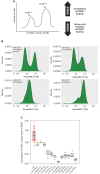mTORC1 functional assay reveals SZT2 loss-of-function variants and a founder in-frame deletion
- PMID: 35773235
- PMCID: PMC9630660
- DOI: 10.1093/brain/awab451
mTORC1 functional assay reveals SZT2 loss-of-function variants and a founder in-frame deletion
Erratum in
-
Correction to: mTORC1 functional assay reveals SZT2 loss-of-function variants and a founder in-frame deletion.Brain. 2023 Aug 1;146(8):e61. doi: 10.1093/brain/awad097. Brain. 2023. PMID: 36996274 Free PMC article. No abstract available.
Abstract
Biallelic pathogenic variants in SZT2 result in a neurodevelopmental disorder with shared features, including early-onset epilepsy, developmental delay, macrocephaly, and corpus callosum abnormalities. SZT2 is as a critical scaffolding protein in the amino acid sensing arm of the mTORC1 signalling pathway. Due to its large size (3432 amino acids), lack of crystal structure, and absence of functional domains, it is difficult to determine the pathogenicity of SZT2 missense and in-frame deletions, but these variants are increasingly detected and reported by clinical genetic testing in individuals with epilepsy. To exemplify this latter point, here we describe a cohort of 12 individuals with biallelic SZT2 variants and phenotypic overlap with SZT2-related neurodevelopmental disorders. However, the majority of individuals carried one or more SZT2 variants of uncertain significance (VUS), highlighting the need for functional characterization to determine, which, if any, of these VUS were pathogenic. Thus, we developed a novel individualized platform to identify SZT2 loss-of-function variants in the context of mTORC1 signalling and reclassify VUS. Using this platform, we identified a recurrent in-frame deletion (SZT2 p.Val1984del) which was determined to be a loss-of-function variant and therefore likely pathogenic. Haplotype analysis revealed that this single in-frame deletion is a founder variant in those of Ashkenazi Jewish ancestry. Moreover, this approach allowed us to tentatively reclassify all of the VUS in our cohort of 12 individuals, identifying five individuals with biallelic pathogenic or likely pathogenic variants. Clinical features of these five individuals consisted of early-onset seizures (median 24 months), focal seizures, developmental delay and macrocephaly similar to previous reports. However, we also show a widening of the phenotypic spectrum, as none of the five individuals had corpus callosum abnormalities, in contrast to previous reports. Overall, we present a rapid assay to resolve VUS in SZT2, identify a founder variant in individuals of Ashkenazi Jewish ancestry, and demonstrate that corpus callosum abnormalities is not a hallmark feature of this condition. Our approach is widely applicable to other mTORopathies including the most common causes of the focal genetic epilepsies, DEPDC5, TSC1/2, MTOR and NPRL2/3.
Keywords: SZT2; epilepsy; genetics; mTOR; variant.
© The Author(s) 2022. Published by Oxford University Press on behalf of the Guarantors of Brain. All rights reserved. For permissions, please e-mail: journals.permissions@oup.com.
Figures



References
-
- Venkatesan C, Angle B, Millichap JJ. Early-life epileptic encephalopathy secondary to SZT2 pathogenic recessive variants. Epileptic Disord. 2016;18:195–200. - PubMed
-
- Tsuchida N, Nakashima M, Miyauchi A, et al. Novel biallelic SZT2 mutations in 3 cases of early-onset epileptic encephalopathy. Clin Genet. 2018;93:266–274. - PubMed
Publication types
MeSH terms
Substances
Grants and funding
LinkOut - more resources
Full Text Sources
Medical
Research Materials
Miscellaneous

